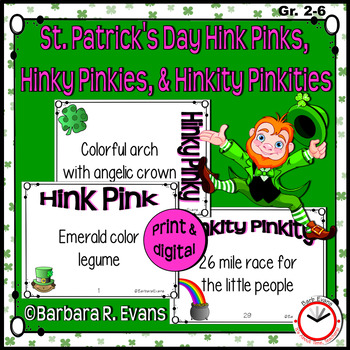It's about time, teachers, for Hink Pinks! If you have ever used Hink Pinks in your teaching, you know how much kiddos love them. If you are new to Hink Pinks, you are in for a treat!
WHAT ARE HINK PINKS?
- Hink Pinks are word riddles.
- Hink Pinks are fun word riddles.
- Hink Pinks are fun word riddles with rhyming answers.
- Hink Pinks are word play.
- Hink Pinks are fun word play that expands vocabulary.
- Hink Pinks are fun word play that expands and extends students' vocabulary.
- Hink Pinks are fun critical thinking exercises.
- Hink Pinks are fun critical thinking exercises that help students learn to interpret data.
- Hink Pinks are fun critical thinking exercises that help students make inferences.
- Hink Pinks are fun critical thinking exercises that help students draw conclusions.
- Hink Pinks are fun critical thinking exercises that teach students to analyze new information.
- Hink Pinks are serious learning disguised as fun.
HOW DO HINK PINKS WORK?
- Read the clues.
- Think of a 2 word answer.
- The answer words must rhyme.
- Each answer word must have just 1 syllable.
Did you figure it out? The answer is barn yarn.
HOW DO YOU USE HINK PINKS?
- as a literacy center
- Place several Hink Pink cards at your literacy center. Direct your students to work cooperatively or individually; whichever works best for your group. Encourage research by placing dictionaries and thesauri at the center.
- as a warm-up activity
- Settle your group and direct their focus by collaboratively solving several Hink Pinks at the outset of your lesson. This works particularly well if you are conducting a pull out or push in program.
- as a sponge activity
- We all face those awkward few minutes when our lesson ends early and we cannot move on to the next part of our schedule because of time constraints. Or we arrive early at a special class and must wait patiently for a few minutes. Carry a few Hink Pink cards with you and use the time to challenge your class. Any time is a good time for critical thinking!
- as an anchor activity
- Engage your students' brains the moment they enter your classroom by posting a few Hink Pink clues each day. Train your students to work on solving them while you take attendance, lunch count, etc. Then discuss the answers at your morning meeting.
- as a fast finishers' challenge
- The biggest disadvantage to this use is that the children love them so much, they may rush through their work just to get time to solve these riddles.
ARE THEY CCSS ALIGNED?
Yes!
- CCSS.ELA-Literacy.L.2.5 Demonstrate understanding of word relationships and nuances in word meanings.
- CCSS.ELA-Literacy.L.2.5b Distinguish shades of meaning among closely related verbs and closely related adjectives.
- CCSS.ELA-Literacy.L.3.5 Demonstrate understanding of figurative language, word relationships and nuances in word meanings.
- CCSS.ELA-Literacy.L.3.5b Identify real-life connections between words and their use.
- CCSS.ELA-Literacy.L.4.5 Demonstrate understanding of figurative language, word relationships, and nuances in word meanings.
- CCSS.ELA-Literacy.L.4.5c Demonstrate understanding of words by relating them to their opposites (antonyms) and to words with similar but not identical meanings (synonyms).
- CCSS.ELA-Literacy.L.5.5 Demonstrate understanding of figurative language, word relationships, and nuances in word meanings.
- CCSS.ELA-Literacy.L.5.5c Use the relationship between particular words (e.g., synonyms, antonyms, homographs) to better understand each of the words.
- CCSS.ELA-Literacy.L.6.5 Demonstrate understanding of figurative language, word relationships, and nuances in word meanings.
- CCSS.ELA-Literacy.L.6.5c Distinguish among the connotations (associations) of words with similar denotations (definitions).
WHERE CAN I GET HINK PINKS?
You might have already guessed that I have a few Hink Pink products in my store. If you want to try them before you buy them, several sets are FREE!
If you like Hink Pinks, I have dozens of them and most have been combined into money saving bundles. Check them out!
If you like Hink Pinks, I have dozens of them and most have been combined into money saving bundles. Check them out!














